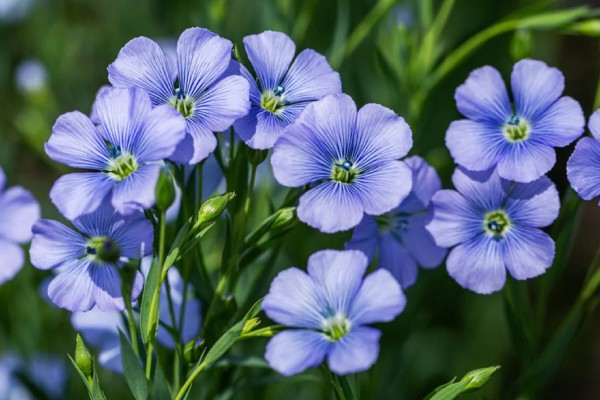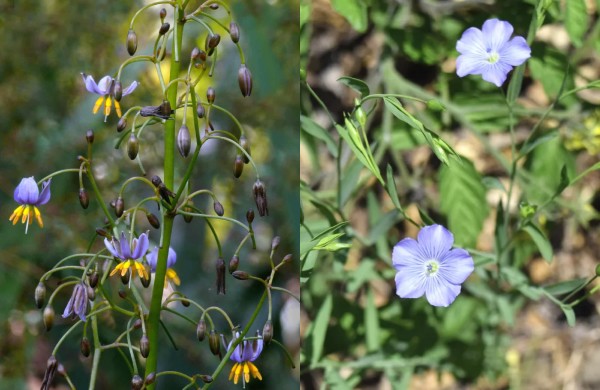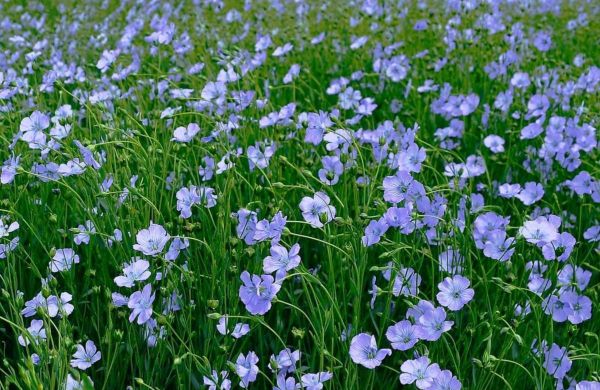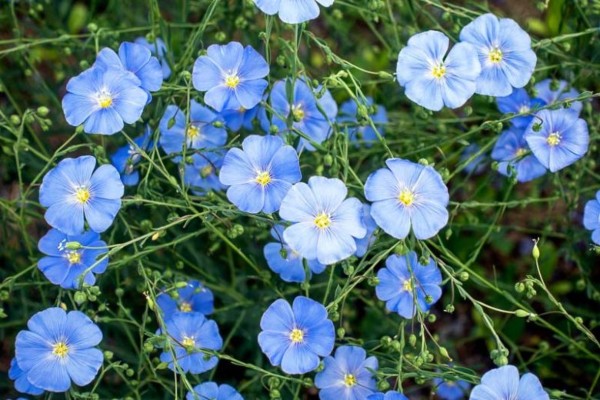Blue Flax is a perennial flowering plant that blooms from late spring to midsummer. It is recognized for its delicate sky-blue flowers and slender, green stems. Similarly, it is a resilient plant that adds charm to any wildflower garden and is simple to grow.
In this article, we will explore how to plant Blue Flax flowers and maintain the plants to extend their blooming period, ensuring a vibrant and continuous display of blooms throughout the growing season.
Overview
Plant Type: Perennial
Season: Spring-Summer
Family: Linaceae
Genus: Linum
Species: Linum perenne
Maturity Date: 2-5 years
Native Area: Europe
Introduction to Blue Flax
Blue Flax, commonly known as flax plant, flax, common flax, or linseed, belongs to the Linaceae family and is scientifically referred to as Linum usitatissimum. This herb is characterized by its blue-green needle-like leaves on graceful stems that grow 1 to 3 feet tall. The stems are tough and flexible, able to be twisted like string.
Similarly, the Flax plant produces pale blue, five-petaled flowers with a delicate, earthy fragrance. These petals make a saucer-shaped flower with a bright yellow center. Birds are attracted to this flower due to its delicate surface. Moreover, the Blue Flax is considered a short-lived flower since each blossom lasts just a single day. Meanwhile, they bloom in the morning but shed their petals by late afternoon.

Although Common Flax is widely used in the textile industry for producing linen fibers, Blue Flax is not directly involved in textile production. Instead, Blue Flax is valued for its ornamental beauty and ecological benefits.
Growing Blue Flax: Essential Care and Growth Tips
Growing healthy Blue Flax requires proper care and cultivation. Fortunately, Blue Flax is relatively easy to grow and can enhance the beauty of any garden. Here we explore the primary care steps to grow Blue Flax flowers while ensuring healthy and abundant blooms.
Light
Blue Flax needs full sunlight, so choose a spot that receives abundant sunlight as it cannot tolerate shade. However, partial shade may be tolerated in southern regions. Nevertheless, full sun is crucial for the optimal growth of flowers.
Soil and Water
Blue Flax prefers slightly acidic, moist, and well-drained soil. Sandy or loamy soil works best, but if the soil is poor, enrich it with organic matter like compost or manure. Avoid wet soil, as it can kill the plant and cause shallow root development. The pH can range from slightly acidic to slightly alkaline. Further, water regularly, especially during dry periods, but avoid waterlogging the soil to prevent root rot.
Temperature and Humidity
Blue Flax is resilient to both cold winters and hot summers, and it can tolerate moderate humidity levels. It thrives in temperatures between 65 and 70 degrees Fahrenheit and prefers a relative humidity of around 75%. Additionally, it can also handle frost, making it adaptable to various climates.

Fertilizer
Blue flax usually doesn’t need a lot of fertilizer. If you do use it, use a balanced fertilizer carefully. Adding too much can reduce the number of flowers. Flax plants are sensitive to fertilizer, especially when they are young, so it is best not to use it unless necessary.
Pruning
Keep taking off old flowers so new ones can grow, and stop seeds from spreading on their own. When the flowering season is almost over, the flax plant might start to look a bit tall and thin. You can trim it down by half to see if it will produce more flowers later in the year.
Potting and Repotting
You can grow flax in containers, but it may not be as striking as a large planting. Use a deep pot with drainage holes and well-draining soil. Plant the seedling, water thoroughly, and place it in full sun. For repotting, select a larger pot, gently remove and inspect the plant, trim any damaged roots, repot with fresh soil, water well, and let it recover in the shade.
Pests and Problems
Keep an eye out for pests such as aphids and diseases like powdery mildew. If you spot any, deal with these pests by using insecticidal soap. Likewise, make sure your plants have good airflow by not planting them too close together, promptly removing any dead or sick plant parts, and spraying them with neem oil.
Propagation Techniques for Expanding Blue Flax
There are two ways to propagate Blue Flax either from seed or cuttings. While both are common, seeding is the simplest and most suitable for beginners. Let’s explore each method of propagating Blue Flax and choose whatever suits you best.
Propagating from seed
- Growing Blue Flax from seeds is simple, making it perfect for those new to gardening.
- Plant the seeds in early spring after the last frost or in fall, and they will start to germinate the following spring.
- Gently sprinkle the seeds over the soil, ensuring they are evenly spread, then delicately cover them with a thin layer of soil.
- Under the right conditions of sunlight and watering, seeds usually start sprouting within 2-3 weeks.
- Additionally, plants originating from seeds may display slight variations, contributing to a diverse genetic makeup.

Propagating from Cuttings
- Growing from cuttings is somehow trickier and requires some experienced gardener.
- Select stems in late spring or early summer when the plant is thriving.
- Cut a healthy 4-6 inch stem just below a node, remove lower leaves, and dip the end in rooting hormone.
- Plant it in a pot with moist soil, cover it with plastic for humidity, and roots will usually grow in a few weeks.
- When you grow plants from cuttings, they look identical.
Also read, What is Dipladenia? How to Grow and Care for This Plant!
Frequently Asked Questions
1. What is Blue Flax?
Blue Flax is a perennial flowering plant that blooms from late spring to midsummer. It is recognized for its delicate sky-blue flowers and slender, green stems.
2. Where can Blue Flax be grown?
Blue Flax needs full sunlight, so choose a spot that receives abundant sunlight as it cannot tolerate shade. Similarly, it thrives in slightly acidic, moist, and well-drained soil.
3. Will Blue Flax come back each year?
Yes, Blue Flax is a perennial plant so, it will come back each year with appropriate care and maintenance, including adequate sunlight, well-drained soil, and occasional pruning.
